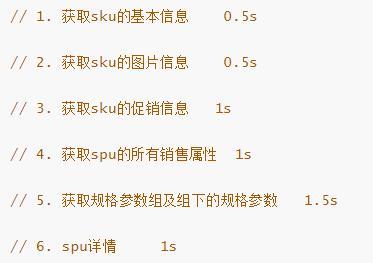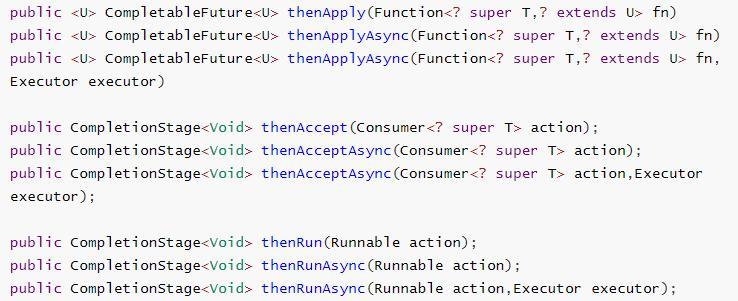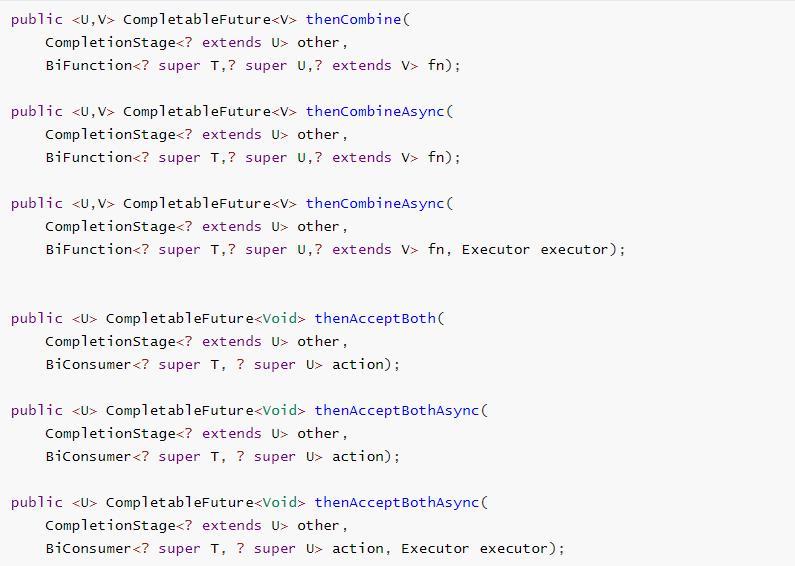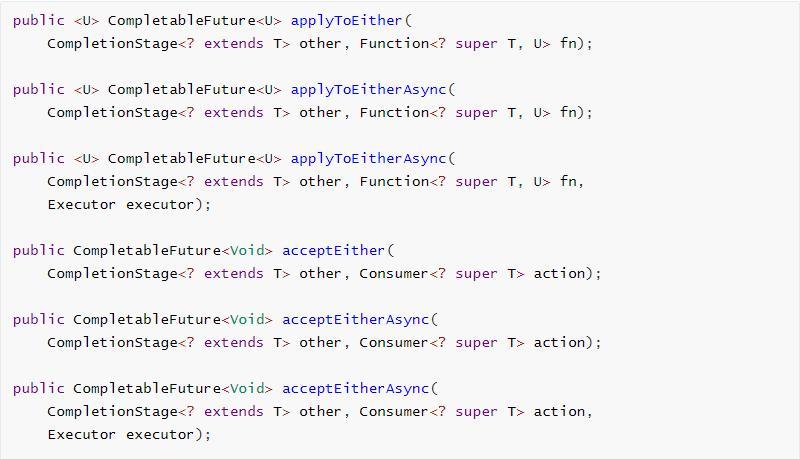CompletableFuture异步和线程池讲解
Posted 咖啡加糖
tags:
篇首语:本文由小常识网(cha138.com)小编为大家整理,主要介绍了CompletableFuture异步和线程池讲解相关的知识,希望对你有一定的参考价值。
一、线程回顾
1、初始化线程的 4 种方式
1)、继承 Thread
2)、实现 Runnable 接口
3)、实现 Callable 接口 + FutureTask (可以拿到返回结果,可以处理异常)
4)、线程池
方式 1 和方式 2:主进程无法获取线程的运算结果。不适合当前场景
方式 3:主进程可以获取线程的运算结果,但是不利于控制服务器中的线程资源。可以导致
服务器资源耗尽。
方式 4:通过如下两种方式初始化线程池
Executors.newFiexedThreadPool(3);
//或者
new ThreadPoolExecutor(corePoolSize, maximumPoolSize, keepAliveTime, TimeUnit unit,
workQueue, threadFactory, handler);
通过线程池性能稳定,也可以获取执行结果,并捕获异常。但是,在业务复杂情况下,一
个异步调用可能会依赖于另一个异步调用的执行结果。
2、线程池的七大参数
corePoolSize:池中一直保持的线程的数量,即使线程空闲。除非设置了 allowCoreThreadTimeOut
maximumPoolSize:池中允许的最大的线程数
keepAliveTime:当线程数大于核心线程数的时候,线程在最大多长时间没有接到新任务就会终止释放,
最终线程池维持在 corePoolSize 大小
unit:时间单位
workQueue:阻塞队列,用来存储等待执行的任务,如果当前对线程的需求超过了 corePoolSize










大小,就会放在这里等待空闲线程执行。
threadFactory:创建线程的工厂,比如指定线程名等
handler:拒绝策略,如果线程满了,线程池就会使用拒绝策略。

运行流程:
1、线程池创建,准备好 core 数量的核心线程,准备接受任务
2、新的任务进来,用 core 准备好的空闲线程执行。
(1) 、core 满了,就将再进来的任务放入阻塞队列中。空闲的 core 就会自己去阻塞队
列获取任务执行
(2) 、阻塞队列满了,就直接开新线程执行,最大只能开到 max 指定的数量
(3) 、max 都执行好了。Max-core 数量空闲的线程会在 keepAliveTime 指定的时间后自
动销毁。最终保持到 core 大小
(4) 、如果线程数开到了 max 的数量,还有新任务进来,就会使用 reject 指定的拒绝策
略进行处理
3、所有的线程创建都是由指定的 factory 创建的。
3、常见的 4 种线程池
newCachedThreadPool
创建一个可缓存线程池,如果线程池长度超过处理需要,可灵活回收空闲线程,若无可回收,则新建线程。
newFixedThreadPool
创建一个定长线程池,可控制线程最大并发数,超出的线程会在队列中等待。
newScheduledThreadPool
创建一个定长线程池,支持定时及周期性任务执行。
newSingleThreadExecutor
创建一个单线程化的线程池,它只会用唯一的工作线程来执行任务,保证所有任务按照指定顺序(FIFO, LIFO, 优先级)执行。
4、开发中为什么使用线程池
降低资源的消耗
通过重复利用已经创建好的线程降低线程的创建和销毁带来的损耗
提高响应速度
因为线程池中的线程数没有超过线程池的最大上限时,有的线程处于等待分配任务的状态,当任务来时无需创建新的线程就能执行
提高线程的可管理性
线程池会根据当前系统特点对池内的线程进行优化处理,减少创建和销毁线程带来的系统开销。无限的创建和销毁线程不仅消耗系统资源,还降低系统的稳定性,使用线程池进行统一分配
二、CompletableFuture 异步编排
业务场景:
查询商品详情页的逻辑比较复杂,有些数据还需要远程调用,必然需要花费更多的时间。

假如商品详情页的每个查询,需要如下标注的时间才能完成
那么,用户需要 5.5s 后才能看到商品详情页的内容。很显然是不能接受的。
如果有多个线程同时完成这 6 步操作,也许只需要 1.5s 即可完成响应。
Future 是 Java 5 添加的类,用来描述一个异步计算的结果。你可以使用`isDone`方法检查计算是否完成,或者使用`get`阻塞住调用线程,直到计算完成返回结果,你也可以使用`cancel`方法停止任务的执行。
CompletableFuture 和 FutureTask 同属于 Future 接口的实现类,都可以获取线程的执行结果。

1、创建异步对象
CompletableFuture 提供了四个静态方法来创建一个异步操作。

runXxxx 都是没有返回结果的,supplyXxx 都是可以获取返回结果的
可以传入自定义的线程池,否则就用默认的线程池;
CompletableFuture<Void> future = CompletableFuture.runAsync(() -> { System.out.println("当前线程:" + Thread.currentThread().getId()); int i = 10 / 2; System.out.println("运行结果:" + i); }, executor);
CompletableFuture<Integer> future = CompletableFuture.supplyAsync(() -> { System.out.println("当前线程:" + Thread.currentThread().getId()); int i = 10 / 0; System.out.println("运行结果:" + i); return i; }, executor); Integer result = future.get();
2、计算完成时回调方法

whenComplete 可以处理正常和异常的计算结果,exceptionally 处理异常情况。
whenComplete 和 whenCompleteAsync 的区别:
whenComplete:是执行当前任务的线程执行继续执行 whenComplete 的任务。
whenCompleteAsync:是执行把 whenCompleteAsync 这个任务继续提交给线程池
来进行执行。
方法不以 Async 结尾,意味着 Action 使用相同的线程执行,而 Async 可能会使用其他线程
执行(如果是使用相同的线程池,也可能会被同一个线程选中执行)
CompletableFuture<Integer> future = CompletableFuture.supplyAsync(() -> { System.out.println("当前线程:" + Thread.currentThread().getId()); int i = 10 / 0; System.out.println("运行结果:" + i); return i; }, executor).whenComplete((res,exception) -> { //虽然能得到异常信息,但是没法修改返回数据 System.out.println("异步任务成功完成了...结果是:" + res + "异常是:" + exception); }).exceptionally(throwable -> { //可以感知异常,同时返回默认值 return 10; });
3、handle 方法

和 complete 一样,可对结果做最后的处理(可处理异常),可改变返回值。
/** * 方法执行完后端处理 */ CompletableFuture<Integer> future = CompletableFuture.supplyAsync(() -> { System.out.println("当前线程:" + Thread.currentThread().getId()); int i = 10 / 2; System.out.println("运行结果:" + i); return i; }, executor).handle((result,thr) -> { if (result != null) { return result * 2; } if (thr != null) { System.out.println("异步任务成功完成了...结果是:" + result + "异常是:" + thr); return 0; } return 0; });
4、线程串行化方法

thenApply 方法:当一个线程依赖另一个线程时,获取上一个任务返回的结果,并返回当前任务的返回值。
thenAccept 方法:消费处理结果。接收任务的处理结果,并消费处理,无返回结果。
thenRun 方法:只要上面的任务执行完成,就开始执行 thenRun,只是处理完任务后,执行thenRun 的后续操作
带有 Async 默认是异步执行的。同之前。
以上都要前置任务成功完成。
Function<? super T,? extends U>
T:上一个任务返回结果的类型U:当前任务的返回值类型
CompletableFuture<String> future = CompletableFuture.supplyAsync(() -> { System.out.println("当前线程:" + Thread.currentThread().getId()); int i = 10 / 2; System.out.println("运行结果:" + i); return i; }, executor).thenApplyAsync(res -> { System.out.println("任务2启动了..." + res); return "Hello" + res; }, executor); System.out.println("main......end....." + future.get());
5、两任务组合 - 都要完成


两个任务必须都完成,触发该任务。
thenCombine:组合两个 future,获取两个 future 的返回结果,并返回当前任务的返回值
thenAcceptBoth:组合两个 future,获取两个 future 任务的返回结果,然后处理任务,没有返回值。
runAfterBoth:组合两个 future,不需要获取 future 的结果,只需两个 future 处理完任务后,
处理该任务。
6、两任务组合 - 一个完成


当两个任务中,任意一个 future 任务完成的时候,执行任务。
applyToEither:两个任务有一个执行完成,获取它的返回值,处理任务并有新的返回值。
acceptEither:两个任务有一个执行完成,获取它的返回值,处理任务,没有新的返回值。
runAfterEither:两个任务有一个执行完成,不需要获取 future 的结果,处理任务,也没有返回值。
7、多任务组合

allOf:等待所有任务完成
anyOf:只要有一个任务完成
三.案例
1.MyThreadConfig.java
//@EnableConfigurationProperties(ThreadPoolConfigProperties.class) @Configuration public class MyThreadConfig { @Bean public ThreadPoolExecutor threadPoolExecutor(ThreadPoolConfigProperties pool) { return new ThreadPoolExecutor( pool.getCoreSize(), pool.getMaxSize(), pool.getKeepAliveTime(), TimeUnit.SECONDS, new LinkedBlockingDeque<>(100000), Executors.defaultThreadFactory(), new ThreadPoolExecutor.AbortPolicy() ); } }
2.ThreadPoolConfigProperties.java
@ConfigurationProperties(prefix = "gulimall.thread") @Component @Data public class ThreadPoolConfigProperties { private Integer coreSize; private Integer maxSize; private Integer keepAliveTime; }
3.使用异步线程
@Service("skuInfoService")
public class SkuInfoServiceImpl extends ServiceImpl<SkuInfoDao, SkuInfoEntity> implements SkuInfoService {
@Resource
private ThreadPoolExecutor executor;
@Override
public SkuItemVo item(Long skuId) throws ExecutionException, InterruptedException {
SkuItemVo skuItemVo = new SkuItemVo();
CompletableFuture<SkuInfoEntity> infoFuture = CompletableFuture.supplyAsync(() -> {
//1、sku基本信息的获取 pms_sku_info
SkuInfoEntity info = this.getById(skuId);
skuItemVo.setInfo(info);
return info;
}, executor);
CompletableFuture<Void> saleAttrFuture = infoFuture.thenAcceptAsync((res) -> {
//3、获取spu的销售属性组合
List<SkuItemSaleAttrVo> saleAttrVos = skuSaleAttrValueService.getSaleAttrBySpuId(res.getSpuId());
skuItemVo.setSaleAttr(saleAttrVos);
}, executor);
CompletableFuture<Void> descFuture = infoFuture.thenAcceptAsync((res) -> {
//4、获取spu的介绍 pms_spu_info_desc
SpuInfoDescEntity spuInfoDescEntity = spuInfoDescService.getById(res.getSpuId());
skuItemVo.setDesc(spuInfoDescEntity);
}, executor);
CompletableFuture<Void> baseAttrFuture = infoFuture.thenAcceptAsync((res) -> {
//5、获取spu的规格参数信息
List<SpuItemAttrGroupVo> attrGroupVos = attrGroupService.getAttrGroupWithAttrsBySpuId(res.getSpuId(), res.getCatalogId());
skuItemVo.setGroupAttrs(attrGroupVos);
}, executor);
// Long spuId = info.getSpuId();
// Long catalogId = info.getCatalogId();
//2、sku的图片信息 pms_sku_images
CompletableFuture<Void> imageFuture = CompletableFuture.runAsync(() -> {
List<SkuImagesEntity> imagesEntities = skuImagesService.getImagesBySkuId(skuId);
skuItemVo.setImages(imagesEntities);
}, executor);
CompletableFuture<Void> seckillFuture = CompletableFuture.runAsync(() -> {
//3、远程调用查询当前sku是否参与秒杀优惠活动
R skuSeckilInfo = seckillFeignService.getSkuSeckilInfo(skuId);
if (skuSeckilInfo.getCode() == 0) {
//查询成功
SeckillSkuVo seckilInfoData = skuSeckilInfo.getData("data", new TypeReference<SeckillSkuVo>() {
});
skuItemVo.setSeckillSkuVo(seckilInfoData);
if (seckilInfoData != null) {
long currentTime = System.currentTimeMillis();
if (currentTime > seckilInfoData.getEndTime()) {
skuItemVo.setSeckillSkuVo(null);
}
}
}
}, executor);
//等到所有任务都完成
CompletableFuture.allOf(saleAttrFuture,descFuture,baseAttrFuture,imageFuture,seckillFuture).get();
return skuItemVo;
}
}
线程异步编排串行(CompletableFuture)
美图

创建异步对象
CompletableFuture提供了四个静态方法来创建一个异步操作
无返回值
- 不需要指定线程池,使用默认线程池
CompletableFuture<Void> runAsync(Runnable runnable);
- 需要指定线程池,使用指定线程池
CompletableFuture<Void> runAsync(Runnable runnable, Executor executor)
有返回
- 不需要指定线程池,使用默认线程池
CompletableFuture<U> supplyAsync(Supplier<U> supplier)
- 需要指定线程池,使用指定线程池
CompletableFuture<U> supplyAsync(Supplier<U> supplier, Executor executor)
示例
CompletableFuture.runAsync(() -> System.out.println("runAsync"));
Integer integer = CompletableFuture.supplyAsync(() -> 100).get();
线程执行之后的回调
在上个线程中继续执行下一步操作
CompletableFuture<T> whenComplete(BiConsumer<? super T, ? super Throwable> action)
在另一个空闲线程中继续执行下一步操作,默认线程池
CompletableFuture<T> whenCompleteAsync(BiConsumer<? super T, ? super Throwable> action)
在另一个空闲线程中继续执行下一步操作,指定线程池
CompletableFuture<T> whenCompleteAsync(BiConsumer<? super T, ? super Throwable> action, Executor executor)
只处理异常结果
CompletableFuture<T> exceptionally(Function<Throwable, ? extends T> fn)
示例
Integer integer = CompletableFuture.supplyAsync(() -> 100)
.whenCompleteAsync((res, throwable) ->
if (throwable == null)
System.out.println("成功的之后的下一步业务");
else
System.out.println("失败的之后的下一步业务");
).get();
出现异常的时候,返回默认值
Integer integer = CompletableFuture.supplyAsync(() -> 100/0)
.exceptionally(throwable -> 10).get();
handle方法
可以对执行之后的结果做修改
CompletableFuture<U> handle(BiFunction<? super T, Throwable, ? extends U> fn)
CompletableFuture<U> handleAsync(BiFunction<? super T, Throwable, ? extends U> fn)
CompletableFuture<U> handleAsync(BiFunction<? super T, Throwable, ? extends U> fn, Executor executor)
线程串行化方法
thenRun
不需要获取上一步执行结果,上一步执行完成,接着执行,无返回值
CompletableFuture<Void> thenRun(Runnable action)
CompletableFuture<Void> thenRunAsync(Runnable action)
CompletableFuture<Void> thenRunAsync(Runnable action, Executor executor)
thenAccept
需要获取上一步执行结果,上一步执行完成,接着执行,无返回值
CompletableFuture<Void> thenAccept(Consumer<? super T> action)
CompletableFuture<Void> thenAcceptAsync(Consumer<? super T> action)
CompletableFuture<Void> thenAcceptAsync(Consumer<? super T> action, Executor executor)
需要获取上一步执行结果,上一步执行完成,接着执行,有返回值
CompletableFuture<U> thenApply(Function<? super T,? extends U> fn)
CompletableFuture<U> thenApplyAsync(Function<? super T,? extends U> fn)
CompletableFuture<U> thenApplyAsync(Function<? super T,? extends U> fn, Executor executor)
以上是关于CompletableFuture异步和线程池讲解的主要内容,如果未能解决你的问题,请参考以下文章
使用JDK1.8 CompletableFuture异步化任务处理
同步OR异步?WebFlux开发真的比Servlet开发要快?顺便再科普下CompletableFuture